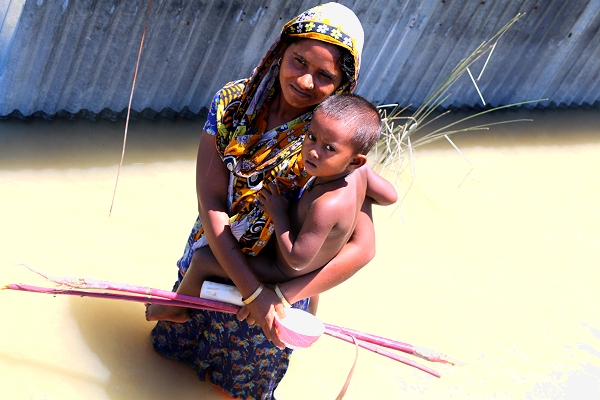
‘Forecasting for humanity: the future of disaster preparation’

(This story appeared first yesterday on the website of the BRACED programme.)
Picture this scenario: you are a development NGO worker who receives a significant flood watch for your area several days in advance of a massive storm system.
You may start coordinating with humanitarian agencies and local governments, but there is very little time to prepare for the event, and recovery supplies will probably not make it to the community for several weeks after the storm.
Now imagine a different scenario: you receive a flood watch for your area three weeks in advance of the storm.
Local governments are alerted by early-warning systems that your NGO has helped set up, and begin to mobilize supplies and manpower. Local governments, humanitarian agencies and community members take preventative actions to anticipate the shock, and supplies are in place before the storm hits.
The latter is the ideal scenario, one that emergency managers and relief agencies dream of.
It is also the type of notice and preparation that could push BRACED communities to greatly enhance their capacity to anticipate disasters.
BRACED projects are making big strides in improving resilience in the face of climate extremes, but these efforts must be accompanied by actionable climate information that is provided with enough lead time to prepare for extreme events.
Imagine receiving a flood watch for your area
three weeks in advance of the storm
The Sub-Seasonal to Seasonal (S2S) Prediction Project is working to realise this vision.
S2S is a research project that seeks to improve forecasting capability in the two-week to two-month range – the critical lead-time for mobilising resources ahead of an extreme weather event.
A joint initiative of the World Weather Research Programme and the World Climate Research Programme, commissioned by the World Meteorological Organisation, the project specifically focuses on high-impact weather events, or those events that have the potential to disrupt life and destroy property – such as floods, droughts, and heat waves.
Perhaps surprisingly, the ability to forecast extreme weather events one month in advance does not yet exist.
Meteorologists routinely issue weather forecasts up to seven days in advance, and climate experts can often provide skilful seasonal climate outlooks three months or more in advance.
The time in between these forecast periods, when weather and climate overlap, has long been considered a ‘predictability desert’ where skilful forecasts could not be made. S2S aims to fill that gap by identifying where and when good forecasts may be possible, and developing the best probabilistic forecasting practices.
‘Ready-set-go’
The International Research Institute for Climate and Society (IRI) and the Climate Centre jointly developed a framework for describing how preparedness decisions, influenced by weather and climate information, can be allocated across timescales, using a range of forecasts.
This ‘ready-set-go’ framework outlines potential preparedness actions based on a seasonal climate outlook, mid-range or sub-seasonal forecasts (this is where S2S comes in), or short-term weather forecasts, depending on the timeframe.
For example, a seasonal climate outlook that predicts higher-than-average precipitation over a region may trigger the training of volunteers and enable the local early warning system.
As S2S forecasts for a heavy rain event become available, they would help trigger more specific and targeted actions, such as warning the community and monitoring river levels.
S2S research will lay the foundation for real-time forecasting (provided through national met services) to support BRACED activities and communities.
Shocks and stresses
For example, S2S forecasts could improve BRACED early-warning systems, by giving communities more time to prepare for an extreme event.
Additionally, S2S forecasts could mitigate the effects of climate extremes on BRACED project implementation by allowing partners to anticipate potential disruptions caused by extreme events.
For example, the 2015 Ethiopia drought impacted beneficiaries of the Christian Aid and Farm Africa-led consortiums, through declines in food security, adoption of short-term coping mechanisms and a myriad of knock-on effects.
Adaptations in programming were undertaken by the consortia to deal with these effects. With greater foresight of possible shocks and stresses, these adaptations to programming can come earlier and prevent impacts before they occur.
With more seamless and accurate forecasts from weeks to months in advance, communities could tailor their disaster preparation, with increasingly targeted actions occurring as more detailed forecasts are issued ahead of the event.
In this way, preparedness could occur in stages, eliminating situations in which it is often too late to take precautionary measures in advance of a hazard.
(The BRACED ‘Reality of Resilience’ team is working with the S2S initiative to identify extreme events that are impacting BRACED projects and could potentially have been forecasted on the S2S timescale. If you are interested in submitting an extreme event for study, please contact us at learning@resilienceexchange.net.)
This July and August the Bangladesh Red Crescent Society conducted distributions of humanitarian cash assistance of the taka equivalent of US$65 to 1,700 families in Bogra district severely affected by monsoon floods (photo), as part of the forecast-based financing programme in the country, supported by the German Foreign Ministry and Red Cross. The FbF disbursements, which came after the flood peak, piloted a new money-transfer system via mobile phones being undertaken in conjunction with Post Office. The photo shows an FbF beneficiary in one of the flooded villages and her child. (Photo: Olaf Neussner/German Red Cross)